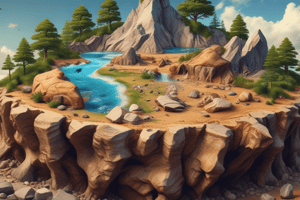Podcast
Questions and Answers
What is the process by which rocks are broken down into smaller pieces due to the effects of water, wind, and other natural forces?
What is the process by which rocks are broken down into smaller pieces due to the effects of water, wind, and other natural forces?
- Metamorphism
- Erosion
- Sedimentation
- Weathering (correct)
What is the finest-grained sediment made up of tiny particles of rock or mineral?
What is the finest-grained sediment made up of tiny particles of rock or mineral?
- Sand
- Clay (correct)
- Shale
- Silt
Which type of rock is formed from pre-existing rocks that have been subjected to high heat and pressure?
Which type of rock is formed from pre-existing rocks that have been subjected to high heat and pressure?
- Igneous Rocks
- Shale
- Sedimentary Rocks
- Metamorphic Rocks (correct)
What is the process by which sediment is deposited and compacted, eventually forming new rock layers?
What is the process by which sediment is deposited and compacted, eventually forming new rock layers?
What is the process by which pre-existing rocks are transformed into new types of rocks due to high heat and pressure?
What is the process by which pre-existing rocks are transformed into new types of rocks due to high heat and pressure?
Which type of fossil is formed when an organism leaves a hollow impression in sediment, which is then filled in by mineral deposits?
Which type of fossil is formed when an organism leaves a hollow impression in sediment, which is then filled in by mineral deposits?
What are the remains of an organism, such as bones, teeth, or shells, known as in the context of fossils?
What are the remains of an organism, such as bones, teeth, or shells, known as in the context of fossils?
What is the process called where minerals from the sediment gradually replace the organism's tissue, turning the remains into rock?
What is the process called where minerals from the sediment gradually replace the organism's tissue, turning the remains into rock?
Which type of rock is formed through the solidification and cooling of magma or lava?
Which type of rock is formed through the solidification and cooling of magma or lava?
What are evidence of the organism's presence or activity, such as footprints, burrows, or nests, known as in the context of fossils?
What are evidence of the organism's presence or activity, such as footprints, burrows, or nests, known as in the context of fossils?
Flashcards are hidden until you start studying
Study Notes
6th Grade Rock Cycle & Fossils
Types of Fossils
Fossils are the remains or traces of prehistoric organisms that have been preserved in petrified form or as a mold or cast in rock. There are many different types of fossils, including:
- Body Fossils: These are the actual remains of an organism, such as bones, teeth, or shells.
- Trace Fossils: These are evidence of the organism's presence or activity, such as footprints, burrows, or nests.
- Cast and Mold Fossils: These are formed when an organism leaves a hollow impression in sediment, which is then filled in by mineral deposits.
- Impression Fossils: These are formed when an organism presses its body against sediment, leaving an impression in the rock.
Formation of Fossils
Fossils are formed through a process called fossilization, which occurs when an organism is preserved in sedimentary rock. There are several steps in this process:
- Decay: The organism's body starts to break down and decompose.
- Preservation: The remains of the organism are covered by sediment, which helps to preserve them.
- Permineralization: Minerals from the sediment gradually replace the organism's tissue, turning the remains into rock.
Types of Rocks
There are three main types of rocks: igneous, sedimentary, and metamorphic.
- Igneous Rocks: These rocks are formed from cooled and solidified molten rock, also known as magma.
- Sedimentary Rocks: These rocks are formed from the accumulation of sediment, which is then compacted and cemented together.
- Metamorphic Rocks: These rocks are formed from pre-existing rocks that have been subjected to high heat and pressure.
Rock Layers
Rock layers, also known as strata, are formed when sediment is deposited over time. The layers are made up of sediment that has been compressed and cemented together. There are several different types of rock layers, including:
- Clay: This is the finest-grained sediment, made up of tiny particles of rock or mineral.
- Silt: This is slightly coarser than clay, made up of small particles of rock or mineral.
- Sand: This is made up of grains of sand, which are small rocks or minerals.
- Shale: This is a type of sedimentary rock that is made up of clay or silt.
Processes in the Rock Cycle
The rock cycle is the process by which rocks are formed, changed, and destroyed over time. There are several processes that are involved in the rock cycle, including:
- Weathering: This is the process by which rocks are broken down into smaller pieces due to the effects of water, wind, and other natural forces.
- Erosion: This is the process by which rocks are carried away by water, wind, or other natural forces.
- Sedimentation: This is the process by which sediment is deposited and compacted, eventually forming new rock layers.
- Metamorphism: This is the process by which pre-existing rocks are transformed into new types of rocks due to high heat and pressure.
- Igneous Processes: This is the process by which molten rock, or magma, cools and solidifies to form new igneous rocks.
In conclusion, the rock cycle and fossils play a vital role in understanding the earth's geology. The types of fossils, formation of fossils, types of rocks, rock layers, and processes in the rock cycle are all interrelated and help us understand the earth's history.
Studying That Suits You
Use AI to generate personalized quizzes and flashcards to suit your learning preferences.




